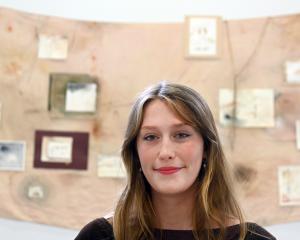He is of the latter persuasion and for many years his art has been concerned with cityscapes and, in particular, the loss of heritage.
"I'm an artist, serious about matters of importance to painting and about painting, but I'm also a citizen who's concerned about the city and civic and architectural and historical heritage, and I guess I'm trying to bring these two things together," he said.
He was in Dunedin recently to hang the the second part of his exhibition, "Preoccupied", at Monumental Gallery in Anzac Ave.
A survey of works from 1998, it was originally installed at CoCA (Centre of Contemporary Art) in Christchurch as "Reverb" but was disrupted a week after opening by the February 22 earthquake which damaged the building.
Some of his works were badly damaged, some unharmed, and some are still in the gallery, as it is unsafe to remove them.
However, Gray managed to rescue most of them and took the opportunity to rehang the salvaged works, along with more recent ones, in Dunedin. Because the gallery space at Monumental is smaller, it is showing in two parts. The second part opened last week and runs until September 4.
"I think it's important to be active socially and politically but that's not to say all art has to be," he says.
He feels people will later regret the haste with which heritage buildings damaged in the earthquakes are being pulled down.
They may be reconstructing a few important buildings, but the historic commercial buildings are the heart of the city, he said.
"Although they may be owned privately, they are in some ways public domain. Certainly, the facade is important for the streetscape.
There's not enough recognition given to that, though a lot of fine words have been said, but there's not enough practical assistance to owners.
There are owners who are very keen [to strengthen or rebuild] but simply can't do it without help from government or councils and I suppose insurance is a big problem now."
He points out that in Europe after the destruction of World War 2, it was the norm to rebuild the historic parts of cities the way they had been.
He became involved in saving heritage buildings about 15 years ago when there was a sudden rash of impending demolitions of important Christchurch buildings, including the Kaiapoi Woollen Mills building.
"I was so incensed I got involved and my paintings soon after started to explore those ideas. I was trying to express those ideas in my abstract way," he said.
"So what I'm trying to do in my two ways is my struggle to retain heritage post the earthquake and to extend my ideas in painting, the painting process that somehow deals with the aspect, but the question is now where to take it.
"I'm still working out ideas, and certainly this recent earthquake when lives were lost - it was horrendous and tragic and it's how to think your way around that in terms of art-making too," he said.
"A lot of it is beyond words. It's just the sense of what needs to happen or what might happen."
Since he was young his work has focused on cityscapes rather than landscapes, probably because of his interest in architecture.
"I've sometimes thought if I hadn't been an artist and a teacher, if I'd had the particular skills with maths and physics, I'd like to have been an architect. I teach drawing to architectural studies students at CPIT [Christchurch Polytechnic Institute of Technology] so I have a lot of contact with things architectural, but I guess it's that human creation of buildings and spaces and cities that fascinates me."
The earthquakes have disrupted the arts communities, as everything else in Christchurch, and many inner-city galleries have had to close, including the Christchurch Art Gallery which as been taken over by the council for offices.
However, new spaces are opening in suburbs, students are finding spaces to exhibit, and there are a lot of arts groups meetings and forums, he saidGray, now in his mid-60s, grew up in Wanganui and studied art at the University of Canterbury in the 1960s.
One of his teachers was Rudi Gopas, a European who came to New Zealand after World War 2 and influenced a generation of artists including Clairmont, Trusttum and Fomison.
"He somewhat scorned the British tradition of landscape and portraiture. He was interested in the interior workings of the painting, the paint itself, the colour and structure and composition - all those things that don't depend on some external reference point."
Over the years, he says, he has consistently experimented, building up layers of paint and form, which he likens to a palimpsest, a layering of the present over the past, in the same way the heritage of a city is built up by the layers of time, the passage of people and the changes to buildings
See it
"Preoccupied", a survey exhibition of works by Ross Gray, is at Monumental Gallery in Anzac Ave, Dunedin, until September 4.












